PROGRAM OF ACTS
* Exhibition Maricel 1910-1936 (provisional title)
Museu de Maricel (ground floor and temporary exhibition hall of Can Rocamora)
October 2018 - February 2019
Curator: Ignasi Domènech, head of Collections of CPS and Sebastià Sànchez Sauleda, art historian and researcher on the old art collections of Maricel during the time of Charles Deering.
The exhibition is dedicated to explaining the history and evolution of Maricel's artistic complex since the acquisition of the old San Juan hospital by Charles Deering, the great transformation carried out by Miquel Utrillo, the growth of the Maricel group and the Its stages and its evolution until 1936, with an epilogue until the present moment. One of the key points of the exhibition is the situation of Maricel in the context of the international collecting of the time, as well as the description of the art collection, for which several works have been requested who had been part of them. Noucentisme, international collecting, Hispanic art and cultural history constitute the four axes of the exhibition. The exhibition will emphasize what Maricel's construction meant for the transformation of Sitges and its new staging as one of the most important cultural spaces in southern Europe.
The sections of the exhibition, which will bring old photographs and unpublished documents together with paintings, sculpture, artistic objects, audiovisuals and models of the set, are configured mainly in three areas:
- The construction of the building: the preliminary of a new architectural language. The artisans and artists who are worthy to collaborate. The transformation of Sitges;
- The main characters: Deering, Utrillo, Casas. The art and collecting market of the time.
- The Deering Collection, bringing to Sitges several of the works that were dispersed in 1921.
On the occasion of the exhibition its corresponding edition will be published guide , in various languages. The exhibition will be complemented by a cycle of conferences, and workshops for adults and school. During the exhibition, guided tours will be offered to groups and also to individuals, in different languages. Possibility of hiring exclusive visits . Before and during the exhibition, the possibility of the Maricel integral itinerary will be offered, a route inside and outside the building dedicated to highlighting its most important historical and artistic aspects.
* Publication of the book Maricel. One hundred years of art and culture in Sitges
Co-edited by the Diputació de Barcelona and the Sitges Heritage Consortium
Direction and coordination, by Vinyet Panyella. Editorial Coordination Fernando Milian and Gemma Peres. Contributors: Roland Sierra, historian; Jennifer Tisthammer, Director of Deering Estate, Miami; Sebastià Sànchez Sauleda, historian of art; Ignasi Domènech, art historian and Head of Collections of the Sitges Heritage Consortium; Carme Camps, documentalist.
Edition in Catalan, Spanish and English.
Appearance: Autumn 2018.
The work deals with the transformation of the old district of Sant Joan; the personalities of Charles Deering and Miquel Utrillo; the construction of Maricel, its stages and the main events, as well as its link to Noucentisme.
* Itinerary Maricel integral
Guided tours of the Centenary for the exterior and the interior of the entire architectural complex, accompanied by an explanatory leaflet for dissemination (edition in Catalan, Spanish, English and French). Duration: Spring 2018 - 2019 winter
* Maricel digital project open
The objective of the project is to make accessible the accessibility through a specific portal to the digitalized documentation of public domain referring to Maricel from various archives and collections, from 1909 to the present day.
Access in Catalan, Spanish and English.
Project in phase planning process (2018-2019).
* School and family workshops
Periodically scheduled and during the exhibition.
* Maricel exclusive merchandising program
The activities of the days dedicated to museums and heritage, as well as those of the Sitges calendar will be dedicated to various aspects of Maricel, and will be announced with the regular programming of the museums of Sitges and through the website www.museusdesitges.cat.
Maricel: history and context
In 2018 the centenary of the architectural set of Maricel, located in Sitges, is celebrated. Maricel is a unique nineteenth-century architectural complex, built between 1910 and 1918 as the residence of the industrialist, collector and American philanthropist Charles Deering (1852-1927) and palace to conserve and show his art collection, mainly Hispanic, built mainly between 1910 and 1918.
Charles Deering is part of the current American art collecting by industrialists and magnates of the time, together with Archer M. Huntington (1870-1955), founder of the Hispanic Society of America (New York, 1904); Henry Clay Frick (1849-1919), founder of the Frick Collection (New York, 1913-1914) or John Pierpont Morgan (1837-1913), founder of the Morgan Library & Museum (New York, 1906). The difference with his American compatriots is that Deering conceived from the beginning his collection based on the construction of Maricel.
The project began in 1910 with the conversion of the former San Juan Hospital to the residence of the North American industrialist, collector of art and philanthropist Charles Deering, and over the course of eight years he expanded for the old buildings that Deering acquired to preserve and display the great collection of Hispanic art that, at the same time, was configuring.
The creator of the project was the engineer and art critic Miquel Utrillo. Utrillo took care of the design and direction of the works, which lasted until 1918, and that radically modified the physics of the old district of Sant Joan, as well as the acquisition and formation of the collection of " deering art. The initial model in which Utrillo was inspired, as he wrote himself in 1912, is the old mansion houses of Can Falç and Can Llopis (now Can Llopis Romantic Museum).
Maricel is one of the most characteristic architectural and artistic examples of the Noucentisme since its inception in 1912, the art critic and museologist Joaquim Folch i Torres and the most important critics and historians of the " art of the moment.
The architectural complex of Maricel covers five buildings and the set formed by the terraces:
- The old Hospital of Sant Joan (s. XIV) converted into sumptuary residence in 1910 and finalized in l914. Currently it is the Maricel Museum ;
- The body that includes the old square of Sant Joan, the current Racó de la Calma on Fonollar street to the called corraló Avenida, which occupies all the space where there was a fishermen's quarter built between 1913 and 1915. It is the Maricel Palace . The bridge that unites both bodies was constructed in 1914 with the function of being a direct communication node.
- The building known as Can Rocamora contains Cau Ferrat and the Maricel Museum acquired by Deering in 1915 and renovated by Utrillo as a winter residence;
- The east wing of the Racó de la Calma, known as the Sarcophagus building (due to the sarcophagus of the 19th century). IV dC placed on its facade). It was built in 1916;
- The body of the building that ran from the corraló until the Rectory, at the Baluard Miquel Utrillo, crowned by the cloister and the tower, communicating the Bau Hall with the Golden Hall with a symmetrical stairway to save the unevenness. It was built in 1917.
- The upper cloister communicates with the terraces that communicate through the part above the entire building. They are one of the most spectacular places in Sitges.
In 1921 Deering took all the art collections and left the closed buildings that, upon his death, passed on to his heirs. In 1935 the Board of Museums rented the Palace of Maricel and in 1954 it acquired the Town Hall of Sitges. The Diputació de Barcelona bought the wing of the Sarcophagus and the Maricel Museum in 1969, and in 1973 it acquired Can Rocamora.
Maricel is part of the cultural life of Sitges since its inception. The name, in addition, by extension and by its meaning, has its name passed to various areas of the local nomenclature, from cultural entities, sports (Maricel cycling rock) to commercial companies. The place is, after the baroque parochial church strategically built in the 18th century, the most emblematic of Sitges.
The buildings of Maricel are managed since 1994 by the Sitges Heritage Consortium (CPS). Throughout their history they have gone through diverse uses, mainly of cultural character. They are currently aimed at museums and cultural activities, with the possibility of renting spaces (Palau de Maricel). Since 1972, they enjoy the maximum internal and external patrimonial protection, in accordance with current state and autonomous legislation and with current PEPPAC and what is currently under review.
Since 2012 the Sitges Heritage Consortium (CPS) works for its conceptual and functional reunification, for the modernization of its facilities, restoration of heritage elements and, in particular, to achieve its full conceptual and functional integration Museums of Sitges. The Maricel Museum has been completely restored and restored (2009-2014).
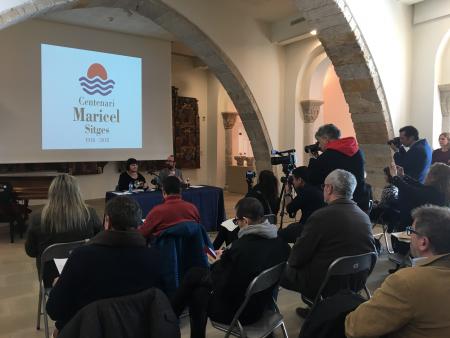
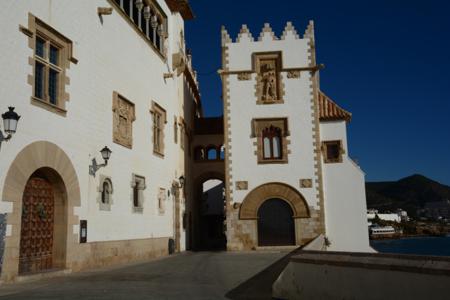
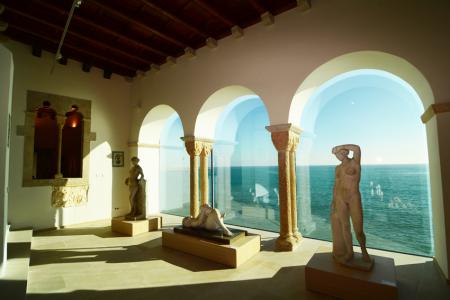
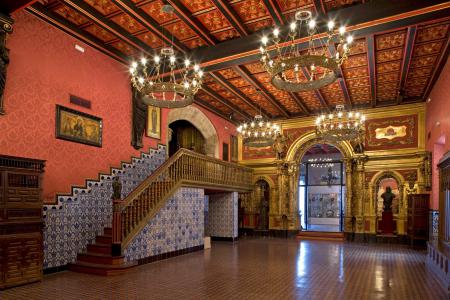
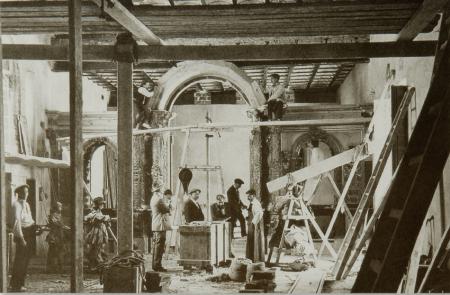


 Buy tickets
Buy tickets Buy tickets
Buy tickets


